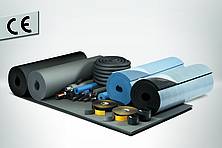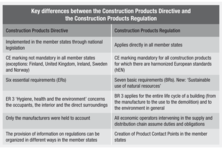By Dipl.-Ing. Georg Eleftheriadis, Armacell Manager Technical Marketing Europe
Münster, 31 October 2013 – The Construction Products Directive (89/106/EEC) was introduced in 1989 to harmonize the classification and representation of the requirements for building products throughout Europe. In recent years, the directive has been revised and on 1 July 2013 it was completely replaced by the European Construction Products Regulation. While the Construction Products Directive (CPD) had to be implemented through national law (in some cases adaptations were even made), the Construction Products Regulation (CPR) applies immediately, in direct implementation in all member states of the European Economic Area (EEA) [1]. The CPR continues to pursue the CPD’s intention to promote the free movement of construction products and remove technical barriers to trade in the single European market. It should now be possible to achieve these objectives more easily, more transparently and more economically.
Basic requirements for construction works
The new regulation maintains many key elements of the Construction Products Directive, but uses new terms in some cases. For example, the six essential requirements (ERs) of the Construction Product Directive have been renamed basic requirements (BRs) in the CPR and a further requirement (Basic Requirement 7) has been added. The ‘Sustainable use of natural resources’ states that construction works must be designed, built and demolished in such a way ‘that the use of natural resources is sustainable and in particular ensure the following:
1. reuse or recyclability of the construction works, their materials and parts after demolition;
2. durability of the construction works;
3. use of environmentally compatible raw and secondary materials in the construction works.’
Another new feature is that Basic Requirement 3 (Hygiene, health and the environment) now refers to the entire life cycle of the building – from the manufacture and use to the demolition. Not only the release of hazardous materials into the immediate surroundings is taken into account, but also the ‘emissions of dangerous substances, volatile organic compounds (VOC), greenhouse gases or dangerous particles into indoor/outdoor air’.
According to the German Federal Ministry for Transport, Construction and Urban Development (BMVBS), environmental product declarations (EPDs) in accordance with EN 15804 can be used to document compliance with the new Basic Requirement 7 and the extended Basic Requirement 3.[2]
Duties and obligations of the economic operators
Unlike the Construction Products Directive, the new Construction Products Regulation defines obligations not only for the manufacturers, but also for other key economic operators, in particular for importers and distributors. All economic operators intervening in the supply and distribution chain should take appropriate measures to ensure that they place or make available on the market only construction products which are in compliance with the requirements of the CPR, which aim to ensure the performance of construction products and fulfil basic requirements for construction works. An important difference compared to the Construction Products Directive is that manufacturers are obliged to declare the performance and importers and distributors are obliged to check this declaration.
Declaration of performance supersedes declaration of conformity
The Construction Products Regulation requires CE marking on the basis of a declaration of performance (DoP) by the manufacturer according to harmonized technical specifications. The declaration of performance supersedes the declaration of conformity in the Construction Products Directive. As was previously the case, harmonized technical specifications comprise the harmonized European norms (hEN) – if available – and European Assessment Documents (EADs), which serve to issue European Technical Assessments (ETAs).
With the declaration of performance, manufacturers document that the construction product conforms to the performance stated in the declaration of performance. The CPR defines the performance of a construction product as the performance with regard to the relevant essential characteristics of a construction product, which is expressed in levels or classes or in a description. With the CPR the significance of the CE marking changes. The manufacturer now documents with the CE marking that he takes responsibility for the conformity of the construction product with the performance stated in the declaration of performance and the compliance with all relevant European legislation. Declarations of performance can be issued per product, product family or other grouping of products. They can be supplied either in paper form or by electronic means. If provided by electronic means, an electronic document is actively transmitted (e.g. as an email, CD or USB flash drive). However, at the recipient’s request a paper copy is to be provided. At a later date, the EU Commission intends to define conditions for providing the declaration of performance on a website.
Duty of care on the part of importers and distributors
Importers and distributors of construction products should be familiar with the essential characteristics and specific requirements in the member states with regard to the basic requirements for construction works and apply this knowledge in their commercial transactions.
The obligations of importers and distributors are set out in Chapter III, Article 11 to Article 14 of the CPR. Distributors of construction products ensure that the product is equipped with the CE marking, accompanied by all necessary documentation (instructions, safety information etc.) in a language which can be understood by the users in the respective member country and that the manufacturer is clearly identifiable. If distributors consider or have reason to believe that the construction product does not conform to the declaration of performance or other applicable requirements under the CPR, they may only make the products available on the market once they conform to the accompanying declaration of conformity or after the declaration of conformity has been corrected. If distributors have reason to believe that a construction product that they have made available on the market does not conform to the declaration of conformity, they must ensure that the required corrective action is taken and, if appropriate, withdraw or recall products. In addition, if hazards are associated with the product, the distributors immediately inform the competent national authorities of the member states where they have made the product available on the market and give detailed information, in particular concerning the nonconformity and the corrective action taken. Furthermore, distributors ensure that storage conditions do not jeopardize the product’s conformity with the declaration of conformity. Distributors cooperate with the competent national authorities and supply all documentation and information needed to document the conformity of the product with the CPR when requested to do so.
Setting up Product Contact Points
The Construction Products Regulation also defines requirements for technical assessment bodies (previously: approval bodies and their assessment and coordination) as well as requirements and regulations for notified bodies and the notification procedure.
In addition, the member states should name or set up Product Contact Points for Construction. This is intended to ensure that all economic operators have access to the national regulations on the legal and technical requirements for CE-marked construction products. In Germany, the Federal Institute for Materials Research and Testing (BAM) provides information regarding the requirements for construction products. The EU publishes an overview of the Product Contact Points in the member states.[3] The Product Contact Points are obliged to answer queries within 15 working days.
Effective market surveillance
The instrument of market surveillance is available to the EU member states in order to monitor compliance with the requirements that apply to construction products and thus to increase confidence in the free circulation of CE-marked construction products. To ensure equivalent and consistent enforcement of harmonization legislation, effective market surveillance should be operated by the member states. Here the CPR refers to EC regulation no. 765/2008, which provides the basic conditions for the functioning of such market surveillance. According to this, market surveillance authorities operate both in an event-driven and in a proactive manner on the basis of a market surveillance programme. In Germany, the Deutsches Institut für Bautechnik (DIBt - German institute for structural engineering) coordinates market surveillance and names the contact points for market surveillance of harmonized construction products in the respective federal states. Since 2011, the German market surveillance authorities also act proactively by monitoring selected building product groups by means of defined surveillance programmes.
National authorities only play a role as market surveillance authorities. They do not have an active role as approval authorities for certain construction products.
Penalties for infringements and transition periods
The penalties for infringements of the CPR concerning the marking and/or the product characteristics are laid down in the member states and are, for example, the recall and exchange of the product and, depending on the intensity of malpractice, fines or prison sentences.
The CPR is only to be applied to products that were manufactured after 30 June 2013. Products that were manufactured before this date do not need to be recertified. For distributors and installers there are no deadlines for using products that are still marked in accordance with the Construction Products Directive.
Conclusion
The new Construction Product Regulation entails significant changes that could only be outlined here. All economic operators involved – manufacturers, importers, distributors, but also specifiers and contractors – are well advised to familiarize themselves with the Construction Product Regulation and its duties and obligations.
The European product standards for insulation materials for building equipment and industrial installations are currently being revised to adopt the nomenclature of the CPR and take into account the extended Basic Requirement 3 (Hygiene, health and the environment).
Preparations to incorporate the new Basic Requirement 7 (Sustainable use of natural resources) at a later date have begun.
Armacell and its predecessor Armstrong Insulation Products played a significant role in the European work on standardization and were one of the parties steering the process from the mid eighties. As the developer of ArmaFlex, the first flexible pipe insulation made of elastomeric foam (FEF), the company founded a completely new branch of industry in the mid fifties. Armacell is therefore particularly committed to shaping the process of European harmonization in this sector of industry responsibly.
[1] The European Economic Area (EEA) comprises the member states of the European Union plus Iceland, Liechtenstein and Norway. The new EU member state Croatia is expected to join later.
[2] See also the article by the same author ‘Green Building gehört die Zukunft. „Nachhaltigkeitspass“ für Bauprodukte: Umweltproduktdeklarationen (EPDs) nach EN 15804’ [The future belongs to green building. Sustainability passport for construction products: Environmental Product Declarations (EPDs) in accordance with EN 15804]. In: Isoliertechnik 3/2003, page 22 – 29.
[3] An overview of the Product Contact Points in the EU member states can be found here: http://ec.europa.eu/enterprise/intsub/a12




